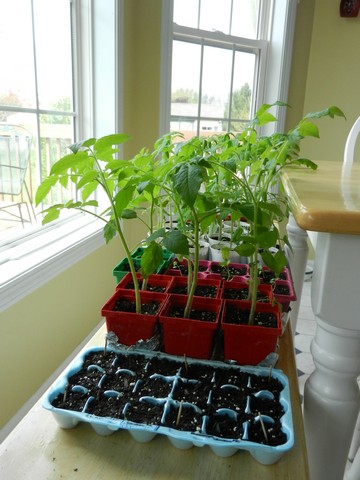
Growing Tomato Plants from Seed
Growing plants from seed can be a very rewarding and fun experience when you start with just a few, basic know-how’s. I have seeded everything from broccoli, peppers, and watermelon, to beans and much more. And, of course, lots of tomatoes! In this post I will use pictures to show you what to do to plant tomato seeds, how to care for the tiny seedlings, and also how to transplant them when the time is right.
The first time I seeded anything at all, more than a decade ago, was a complete flop. Since then, I have learned just how easy it can be and have grown to really love seeding my own plants. My absolute biggest mistake in the very beginning was to put the newly seeded trays away from where I could see them, in order to also keep them away from my cute little toddlers. The problem was that since I didn’t see them, I forgot about them (the trays, not my toddlers! Ha!) and didn’t water the seedlings often enough. When I did water, I didn’t realize just how fragile these tiny plants were, and knocked them over while watering from a watering can that was far too forceful for them. The poor little plants didn’t stand a chance and quickly gave up. And so did I. I did not believe I had it in me to grow anything from seed!
It took years before I decided to try again, this time to find that I do, indeed, have it in me! And most likely, so do you! Now that I keep my sprouting little seedlings where I see them daily, and tend to them carefully, I have grown countless tomato sprouts into huge, beautiful, lush plants, many of which were transplanted into my own garden, and still more that I have had the pleasure of sharing with others.
Selecting Seeds
Which type of tomato you will want, and how large you prefer the tomatoes to be, will of course be one of the first things to think about. However, there are some other things to keep in mind as well, when selecting seeds:
Plant Size:
Some plants are determinate, others are indeterminate. Indeterminate plants will continue to grow and produce fruit all season long until the plants die from hard frost in the fall. If they are in ground and conditions are right, some will grow to be 8 feet tall or more, requiring heavy staking, unless you want it sprawling on the ground catching diseases and not get enough sun for a good harvest. A grape tomato plant that I gave to my father-in-law grew high up into a nearby tree! When in pots though, they will not necessarily grow much beyond 4-5 feet.
Sometimes determinate plants can be more manageable as they grow to a certain size and then stop. They usually do not require staking as they will stay more compact, perfect for a patio. However, they will grow only one crop of tomatoes that will all ripen at about the same time, great for canning season but not if you want tomatoes all summer long. I have grown both determinate and indeterminate plants on my deck and in ground without a problem. I would not let size be the determining factor (no pun intended) when choosing seeds or plants unless space was a true problem.
Hybrid vs. Heirloom:
Most tomato plants and seeds available at stores and nurseries these days (as well as supermarket tomatoes) are hybrid varieties, which means they have been specially grown and bred to create disease resistant and hardy plants and fruit. Flavor is often sacrificed, though there is still no comparison between a homegrown tomato and one from the store! Fruit that has been allowed to slowly ripen on the vine is so much worth the effort it takes in caring for the plants.
Heirloom tomatoes, which have been reproduced for several generations, are often more flavorful, but these plants are prone to disease and harder to care for. Seeds from heirloom tomatoes can be kept and seeded the following spring and the new plant’s fruit will stay true to its original tomato. Seeds from hybrid plants will grow if they are planted, but you cannot know what type of tomatoes you’ll end up with because of cross pollination. This means your original disease resistant hybrid plant can produce seeds that will result in diseased plants. Therefore, seeds from hybrid tomatoes should not be used.
How many seeds to purchase and plant?
I usually seed for a lot more plants than I want to keep. Personally I want to start out with at least three times as many plants as the number I actually want to keep, and sometimes I start with two seeds in each cup with the plan to weed out one of them. *More information on this below. By seeding extras, I can select from and keep the strongest ones, toss the weak ones, and share the rest of the good plants with friends and family. But I do often end up with a forest to care for, for a little while!
When and How to Plant Tomato Seeds
Most tomato varieties should be planted 6-8 weeks before the last expected day of frost for your area. For me, in zone 5, that means Memorial Day or end of May. I like to give them ample time, so I plant around March 20th or so.
Personally I find egg cartons to be the perfect starter home for tomato seeds. I put down the date of seeding directly on the “tray”, and sometimes, if I seed different plants in the same tray, I will number each cup and keep track of the different plants in a notebook.
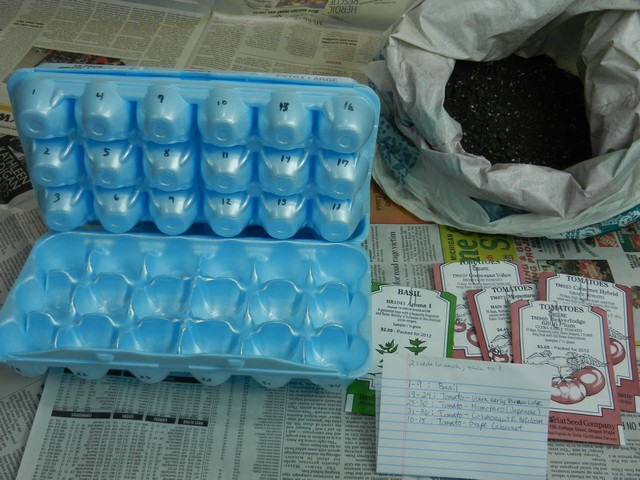
Fill the egg carton trays with potting mix, placing the seeds on top, then covering with more soil. How much to cover with depends on the seeds you are using. You will see this information on the seed packets, and I use this info as approximate debts. You can also fill the cups first, then make little holes for the seeds, stick them in and brush the soil over. Whatever you find easier.
It is best to use a bagged potting mix rather than soil from outside, as potting mix is lighter on tender roots, and clean. Soil from outside tends to pack too much and can carry disease and contaminants that you won’t want in your house or spread to the gardens of people you share plants with. (I will refer to the potting mix as soil in this post, just to clarify.)
*In the following picture (very blurry, unfortunately), you can see some little yellow dots on top of the soil, two in each cup. These are the seeds. I put two or three seeds in each cup and later remove the weakest plants to allow for one in each cup. Some seeds might not sprout at all, especially if they are from previous seasons, so it helps to guarantee you one good plant in each.
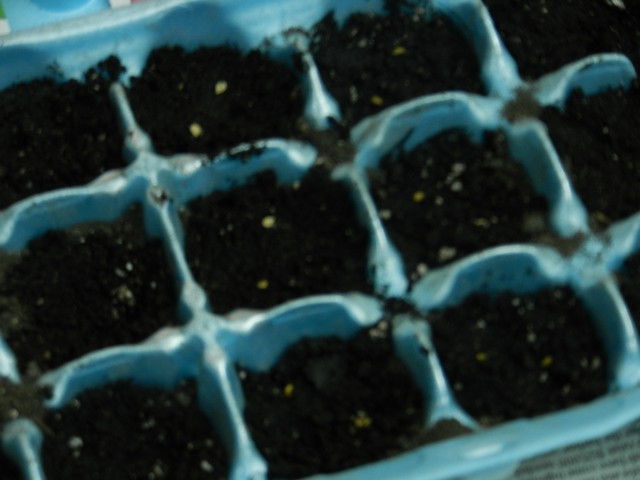
For these seeds, I covered with approximately 1/4 inch of potting mix. If you use seeds from your own heirloom plants, a general rule is to cover with soil as deep as the length of the seed; if the seed is 1/4 inch long, cover with 1/4 inch soil. Gently water with a sprayer so that the water flow will not disturb the seeds or cause them to shift. This is a fun job for kids, and my 10 year old son does a great job as you can see on the next picture. I generally have him do two sprays per cup, checking to see how that works out. You’ll want the soil to be damp, not soaked. Holes on the bottom of the cups should not be necessary at this stage with careful misting of water.
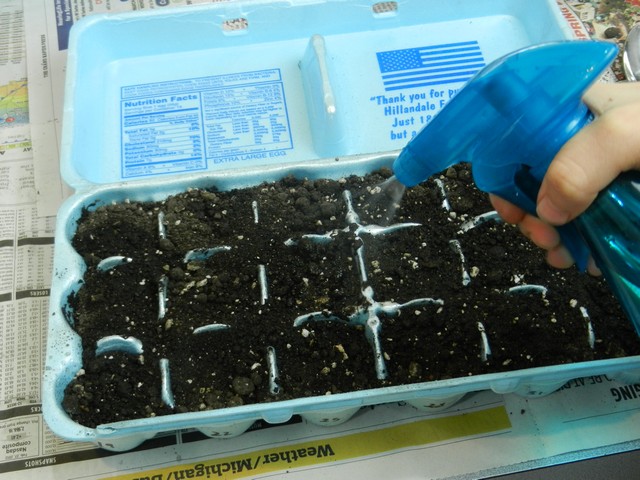
Before sprouting, seeds do not require light, but warmth is important. After the sprouts emerge, they should be placed in an area where they receive a lot of light, and temperatures of at least 65 degrees. As they begin forming a lot of leaves, they will require direct sun most of the day. Tomato plants love full sun and warm weather, and will not produce properly without it. I have found my plants to struggle more with disease in years when we have had a lot of rain and overcast.
And make sure you have someone to guard the trays at all times! My guard’s name is Jasmine, or Jazzie for short. You can just tell how she’s scanning the area for potential threats! She’s looking out for us, just like always. Yeah.
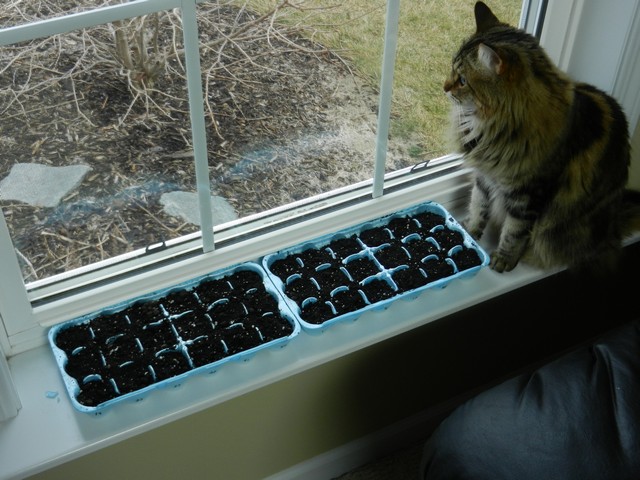
To make a tiny, miniature greenhouse, I cover with plastic foil and poke a few holes in it to allow for air circulation. The plastic will help warm up the soil just a tad, and will also help retain moisture to prevent the plants from drying out. I do check on the plants every day, and mist with water whenever needed. Remember: moist, but not wet.
If it should accidentally happen that the soil gets overly wet, you can gently put some paper towel loosely on top of the soil to absorb as much as possible, and remove the plastic until the excess water has evaporated. The soil will pack together when this happens, so it is not an ideal situation. A sprayer will be very helpful in preventing an accidental over-watering.

And here’s the very first little babe!! A little girl! OK, maybe not… But this is getting very exciting! I usually check several times a day at this point, just because I find it so fascinating! These seeds mostly sprouted on day 5 and 6, but this can vary by several days. I had one sprout as late as day 16 this time around.
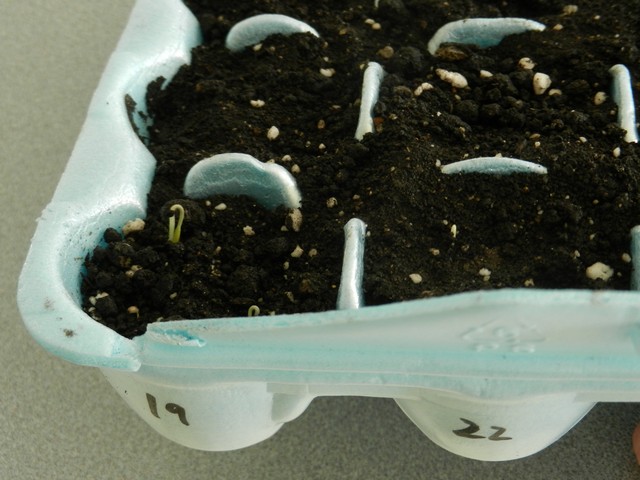
In the next couple of days, as the tiny sprouts start to grow taller, I often stick down blunt-end toothpicks or similar, in the soil to help hold the plastic up and away from the plants. Otherwise they will not have the room they need to grow. This is now day 7, so it’s only a day or two after sprouting. Some are still working on developing their seed leaves.
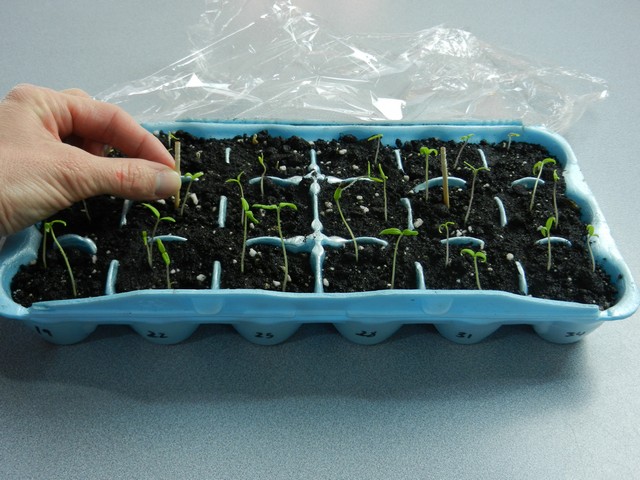
Spacing the Plants
The time has come to start spacing the seedlings, to allow for plenty of room for individual plants to grow. Select the strongest plants to stay, and snip away the rest. I keep the ones that look the healthiest, thickest around the stem, and generally have come the furthest. I just snipped off the one I’m pointing to here, …
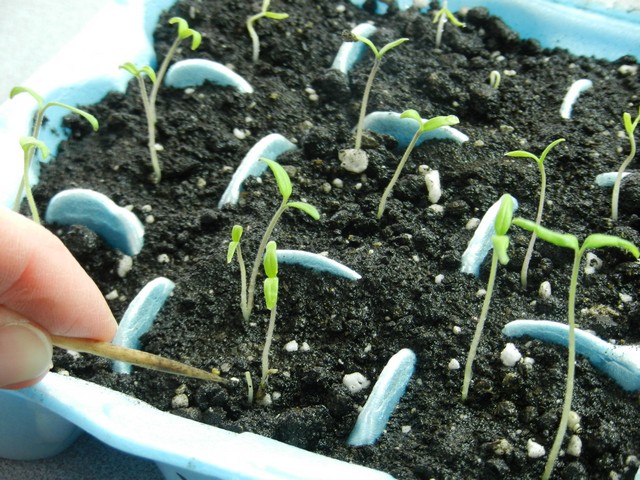
…and will remove this one too since it’s growing too close to a different one:
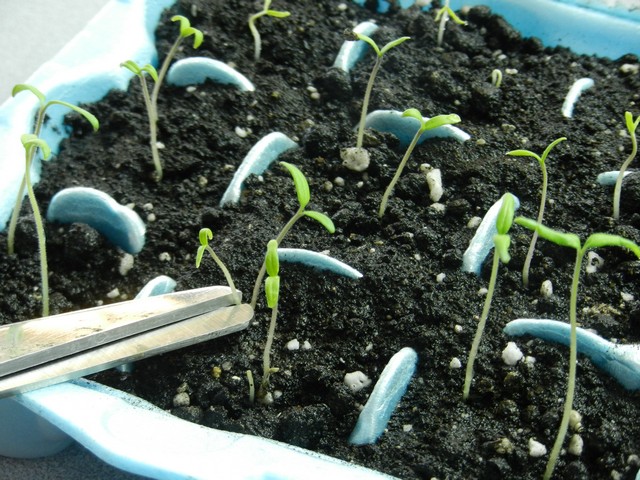
Don’t just yank them out, but snip them off gently so you don’t disturb the roots of other plants growing nearby. You can use your finger nails as well; just cut them off. The remaining stem and tiny root system will wither, so you can leave them alone. In another few days I will remove more plants until I have only one per cup remaining.
In this next picture, you can see the beginning of the next set of leaves, which is the first set of true leaves. They started emerging on day 10. As these true leaves develop, you will eventually see the seed leaves, the original first set of leaves, wither and drop. This is no reason for concern. In fact, you should expect this to happen, as the tiny sprout now has used up the nutrition found in these leaves, which was used to sustain the plant in the beginning.
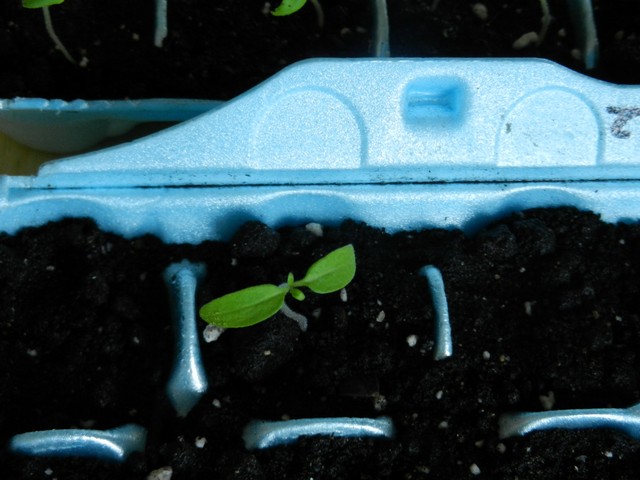
I am now down to one plant per cup, and they are strong enough to handle watering from a bottle rather than the sprayer. This is faster and easier, and I have found a regular drinking bottle with a top on to work very well. I just give each cup a few dribbles and move on to the next. I have basil growing in the front left cups. Tomatoes and basil thrive very well together and can be grown side-by-side in the garden.
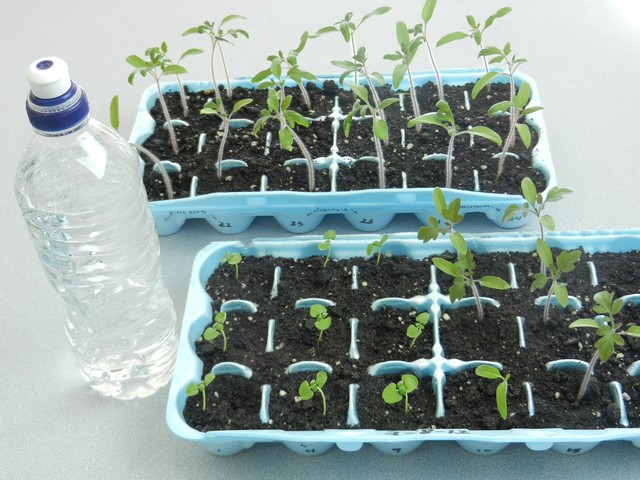
Transplanting Seedlings
When the plants are about 2-4 inches tall with at least one set of true leaves, they should be transplanted to a cup or pot of larger size than the tiny egg carton cups. I just dig them out with the surrounding soil, using a spoon, then transfer to the larger container. Because we had unusually warm weather at the time, I was able to do it outside, but then quickly moved them back inside.
**NOTE: Can you see the tiny hairs on the pink stems? Keep that information in the back of your mind for now…
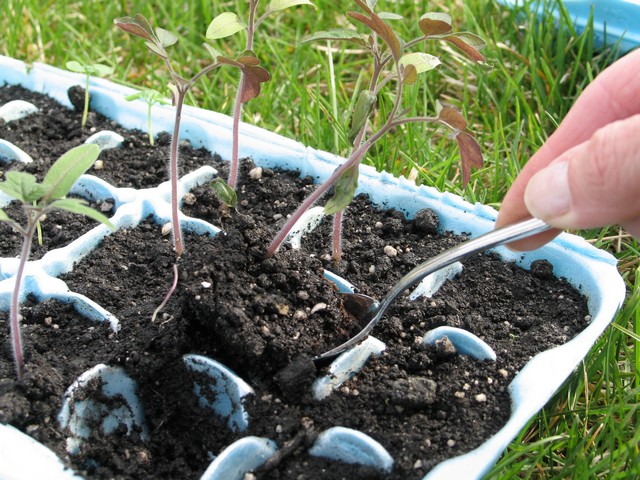
It is a plus if the container has holes on the bottom for drainage of excess water. You can see the withered seed leaves still hanging on to this plant. They can be removed if you wish.
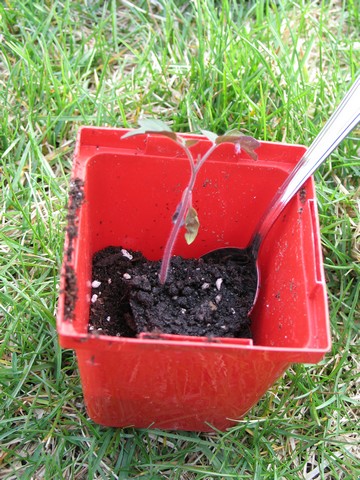
This next step is very important: Place the tiny root ball quite far down into the pot, then fill with soil. **Remember the little hairs on the stems? Here’s why that matters: When you plant deeply and cover up the stem, all these tiny hairs will grow into roots, which will ensure that the plant has a strong, solid root system. Cool, huh?
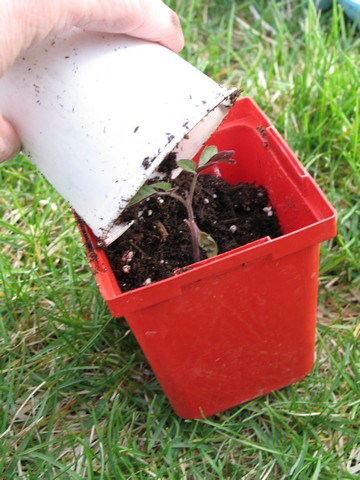
So you cover up until you’re about 1/2 – 1 inch from the bottom of the true leaves. The plant looks so tiny buried in the new pot, but it will grow very quickly from now on! Water, then place inside in a sunny, warm spot.
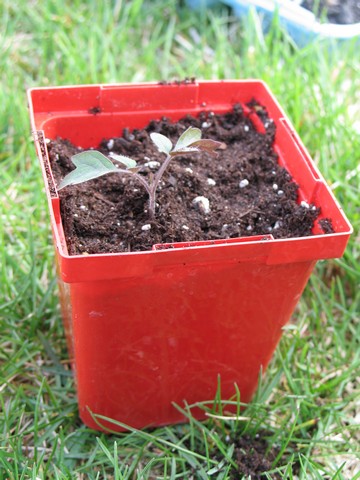
At this point the plants will grow very rapidly; pretty soon as much as several inches a week. That means they will need a lot more water as well. As they grow even taller, I often find myself watering twice a day. With holes on the bottom of the pots, and a tray underneath to catch excess water, I don’t worry as much about over watering as the plants absorb so much of it and the extra drains out. I give a good squirt or two in each pot. Sometimes I just wrap aluminum foil around the bottom of each pot to use as mini trays, and other times I use old cookie sheets to hold several plants.
I usually give away the extra tomato plants once they have been transplanted successfully to larger pots and continued to grow happily for another week.
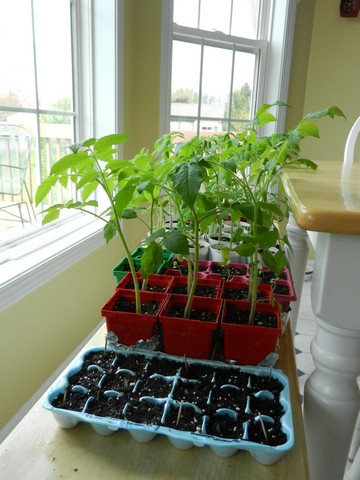
When they are as large as on the next picture, it is on high time to select the ones I want to keep and get the rest of them out of my kitchen and on to their new homes. They are growing large and will need to be weathered to prepare them for outdoor planting. Weathering means to give them daily outdoor sun and air, a little more each day to help them get used to the outdoors to transition better. I will go into more detail about this simple process in my next post, Growing Tomatoes Part 2: Transplanting Outdoors and Care. In my third post on this subject, Growing Tomatoes Part 3, I will touch on a couple of common problems to be aware of, and what to do in this regard.
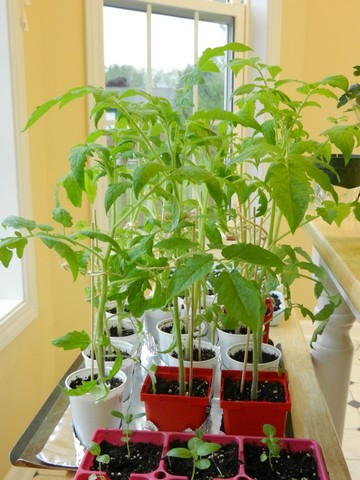
This is also a good time to stake the plants if not already done, to help hold them upright. I just use kabob skewers and string.
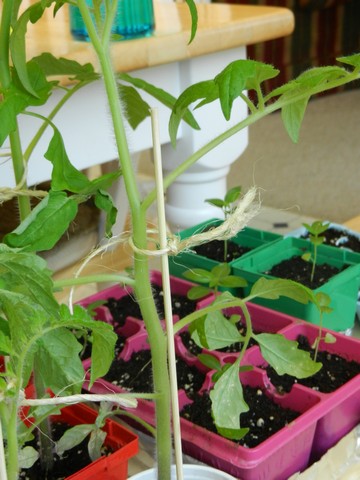
Very soon, the teeny, tiny sprouts will look like this, and indeterminate plants will only keep on growing from here:
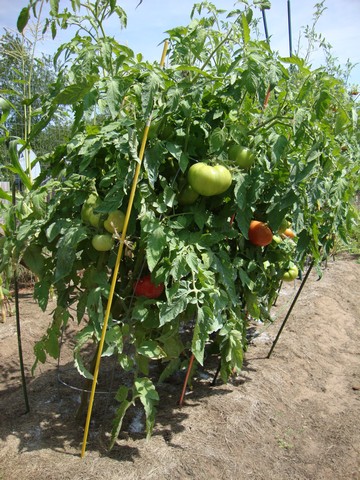
My post Growing Tomatoes Part 2: Transplanting Outdoors & Care includes great information about how to transplant to large pots or in-ground, as well as general care. And in Growing Tomatoes Part 3, Common Problems & Solutions, I go through diseases and disorders and what to do to prevent or treat. I also have a post on tomato hornworms as these fascinating but destructive worms deserves a chapter all to themselves! They will make you choose between them and the tomatoes!
Seeding, transplanting seedlings, and growing larger tomato plants is quite easy, as you can see on these pictures. It is also very rewarding when you see your wonderful harvest of red, flavorful, homegrown tomatoes that you have grown from they were tiny seeds! Just a little bit of information on how and when will go a long way in knowing what to do to be successful. What a miracle, the life and potential that God has placed in these little seeds that are now producing scrumptious and nutritious food for your family!
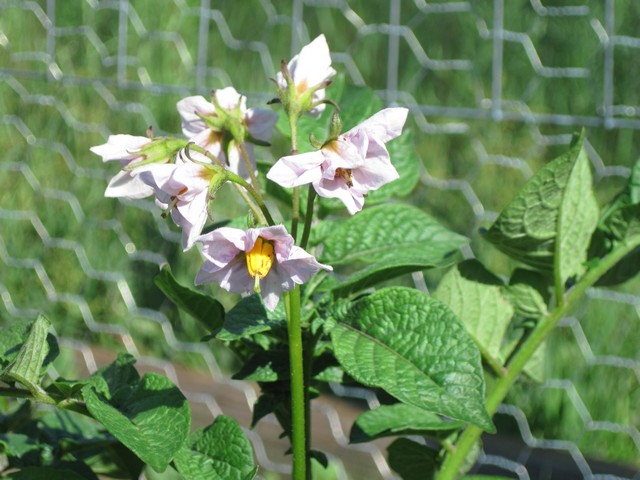
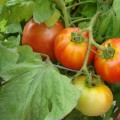

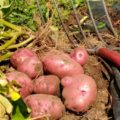
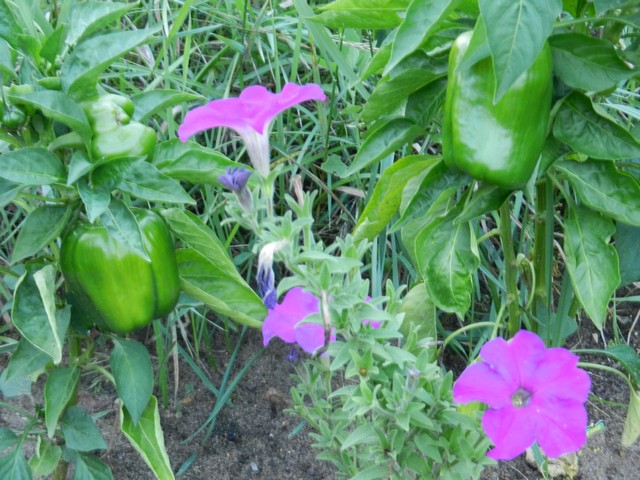
Thanks so much for the information and the pictures. For the first time I am going to plant some seeds for beefsteak tomatoes and also sweet peppers. Going to use the egg carton method you mentioned. I have a balcony that gets lots of good sunlight.
That’s great! Just be aware that beefsteak tomatoes are extremely large and can be very heavy for the plant to carry, so you may want to stake these plants very well to help support it. I hope you’ll have a lot of fun and that you’ll have an abundance of awesome tomatoes come July / August!
Thanks for your reply. Yes, knew they were large but we love the taste of them. Will stake them really well. Hope to take pictures along the way. It really will be fun. Will keep you posted!
Please do! Have fun!!
Very wel written directions. I am going to start tomato seeds for my raised bed here at assisted living. Wish me luck!
Thank you! And I do wish you very well with it, I hope your plants will grow and thrive and that you will enjoy the process! Please let me know if you have any questions at all! Have fun, and thank you for leaving me a comment!
Thank you so much for this post and pictures!! I haven’t ever tried seeds before, but started last week. I saw a post on Pinterest using used paper towel rolls to plant and unfortunately there is white fur (gross) growing on the outside of two. I will use your egg carton trick for thenext batch. Are they too tiny to move into another container? I’m learning on the fly! Thanks!!!
Sounds like they might be growing some mold. My guess is that you’re over watering, and that’s why the white fuzz has developed. You could try to let them dry out some, to stop the mold from growing. It seems like they should be fine. Don’t let them get entirely dry and hard, just barely moist but not wet until it’s under control. Then keep them moist on top but not necessarily all the way to the bottom until the roots develop more. Since you already have them planted, I would personally try to keep them there. But if you really want them in egg cartons, I would try to transfer these plants you already have rather than giving up and starting over. Egg cartons can be convenient, but they are very tiny, so it won’t be too long and they’ll grow out of them. You should still only have to transfer once before you plant them outside. So I do like them.
I used old muffin tins with the paper liners to start seeds. They are very easy to remove for transplanting and the paper liners are bio-degradeable
That’s a great tip! Thank you for sharing!
Hi,
I found your site through Pinterest and I must say I’m very impressed with this article on starting tomatoes from seeds. I reposted it to my Pinterest board, and my facebook page for others to see.
I’m curious, do you add any amendments to the potting soil? And do you use a generic potting soil or one especially for starting plants?
Thank you so much for this detailed article and the great photos.
Pat Hendirks
Thank you, Pat!
No, I do not add anything to the soil, and I’ll use either potting mix or seed starter, whatever I have on hand. Both have worked for me. One year I even grabbed soil from my own garden, which worked, but not as well. I found that it hardened a lot more when it dried between waterings, and of course there is always the risk of pests or disease. So I otherwise always use seed starter or potting mix. When I replant into bigger cups, I’ll use some type of soil and not just the starter mix.
Thank you so much for this post! I was hoping to grow tomatoes from seeds this spring and had no idea where to begin! This gave me the confidence to give it a go!
That’s great! I’m so glad I could help inspire you to try it, and I hope it will go very well for you!
This is a great article thank you! I live in idaho and am considering starting my seeds early just to get a jump on my growing season.
Hi Teresa,
Love your site!
I am a beginner, I used to plant tomatoes from the nurseries, but unfortunately I cannot find my favorite type-whopper, so I decided to grow them myself. I had bad experience, my tomatoes got leggy and died….
Question about what type of soil to use when your planting the seeds. You used the pot mix soil, what about “seed starter mix”?
Also where do u buy the seeds, any good on line stores?
Many thank!
Irina
Potting mix or seed starter are both fine to use. I’ll use either one. I often purchase seeds directly from plant centers in our area, otherwise I’ve also purchased from Territorial Seed company online. Last time I ordered I purchased from Trade Winds Fruit online because their prices are lower. Especially shipping. If you purchase one envelope, it’s $8 at TSC, and $5 at TWF.
I found that wicking the small starter containers with a hole in the bottom and put a piece of shoe string through allowing the string to be in the container and in the bottom holder of which has water to wick up to the soil.
Great idea! Thanks for sharing your tip!
I can say thank you enough for this walk through! Ah! I was doing it all wrong and they just kept dying. Thank you, thank you!
I’m sorry you had previous struggles, but glad that I could help! Hope things will go better this time around. At least you haven’t given up, that’s good! Have fun with it!
I live in zone 8, Can I plant tomato outside now?
I don’t know your zone will typically plant outside; what I do know is that you MUST avoid frost at all cost. If you do plant at this point, and frost is possible, pay attention to weather forecast frost warnings and cover the plants if it is predicted. You could also check with a garden center or figure it out online to see what the recommendations are for your area. HTH!
Thank you for sharing such an informative post for first time gardeners like me. I love the step by step pictorial representation, it definitely helps. I am going to bookmark this page as I know i am going to be referring to these posts often.
Thank you, that’s nice to hear! I’m glad I could help!
Question: When transplanting seedlings to larger pots, what soil do you use? Regular potting soil or garden soil? By garden soil, I mean a bag of miracle grow garden soil as opposed to regular potting soil.
Thanks,
Nancy
I’m not sure if you mean the seedlings after they have first sprouted, or if you mean larger plants for container gardening? For transplanting seedlings to cups, I’ve used different things, but I’ve concluded that it’s best to use potting mix or potting soil. Never soil from the outside garden as you’ll introduce disease. The bagged soil you mentioned should be OK, though potting mix is probably best as it won’t compact easily and drains well. It also often contains fertilizer and will feed your plants until you have transplanted into large containers or in-ground. Potting mix in itself contain little or no nutrients, so they often add fertilizers to make up for it, which will sustain the plants for a while (up to 6 months, I believe). For container gardening I would personally use a soil of some kind, though it is possible to still use potting mix here too, though you’d have to definitely stay on top of fertilizing. You would have to with soil too, though… But soil is more nutritious to start with.
i planted 2 tomato plants in a tomato bag. They have grown beautifully and now have several tomatoes on them(not ripe yet) But I have noticed that they are wilting on a regular basis. I am thinking they are getting too much sun or the tomato bag is now crowded or both. Should I attempt to transplant one of them?
If the plants are wilting, could it be that they are not getting enough water? They do need a lot of water to support the foliage and the tomatoes. Sun would not be an issue as tomato plants love sun. It could be that the roots are crowded, it really depends on the size of the bag and the plants. You could try to transplant if you’re able to do it gently, but I don’t know how it’ll go this late in the game. I’m imagining it will be hard on the plant since it’s in full production and concentrating on fruiting right now. But my best guess is that they need more water. Try to not let them dry out.
i however did not read thoroughly before transplanting my tomatoes to my garden. They’re still little but have good true leaves. My question is, I had them in the egg carton, there was about 3 plants starting per little spot, I kept them together and planted the whole thing of dirt with all 3 plants together in the garden. Should I go cut off the 2 weaker ones, or keep them all together since I planted them like that! I’m a newbie
We were all newbies at one point, so no worries! In another little while you’ll be experienced and can help advice others! 🙂
I would definitely snip off the two weaker ones. Tomato plants and roots need a lot of room to expand. If you leave them grow together like that, I fear you won’t have the yield you otherwise could have. So yeah, get rid of two and leave one growing and thriving! 🙂 Excellent question, though! Some plants can remain together, but I would not do that for tomatoes.
Hi Therese! I Live in Bangalore India. A local Tomsto Sauce company ran a promotion where they gave away a free pkt of tomato seeds to plant tomatoes at home! That took me to pinterest and I found your very helpful site that I promptly ” pinned” under my other tips and anm now well on my way to growing tomatoes in my sunny balcony! Was so inspired by your tips! This morning, am most deloghted to see the little green leaves sprout out and cant wait to put them into bigger pots in the next few days after they grow a little more! Thank you so mich and good wishes to all your other readers….all the way from India!
How fun to get a comment from a reader so far away, India!! Thank you! It is so exciting to see the sprouts when they first emerge! The season has just ended for me here, we’re getting ready for winter and snow. And in the meantime, you are just starting and can look forward to watching your plants grow and produce! I hope you’ll have a lot of fun watching the process and enjoying tasty tomatoes before long! Happy growing!
Hi Terese! Love yr detailed explanation n great inspiration for tomato-growers wannabe like me. After reading so many sites, i found yours come truly from yr heart. Thanks n hope u’ll continue to write. By the way, tickled with the pic above on yr tomato guard?
That’s very nice to hear, thank you!
I want to try and grow some plants inside this winter. I live in Chelan Washington zone 7 There does not seem to be anyone here I can ask but do I put my seeds in a large pot and do not transplant. At least can you tell me where to look
I find a site that told me that my local wal-mart would of help. I asked she did not know anything about it.
Well, I’m not quite sure what your question is; I can try to help you, but not sure exactly what you are asking. Otherwise plant centers normally have people on staff that can help, or you could try the garden web on houzz.com. I hope you find the help you need!
Hi Teresa, U will be suprised as this is coming all the way from africa, Nigeria. I started my tomatoe garden without any professional knowledge specifically and as such i never knew i will have to transplant in a bigger pot with before transplanting finally to the ground. Infact i did my nurseries inside the garden, as the percel of land is so so big, i have enough space. I only intend to transplant to the ground for the second and last time. I sow’d my seed on 27th Nov and by now they are past that stage of transplanting to bigger pot and looking forward to January to transplant, they are currently at 6-7inch. What danger or effect does dis pose to their development pls, and what re the chances of having a bountiful harvest. And pls u know its extremely hot here, do u think i can still apply ur recommended spacing of watering. Or reduce the intervals of days. Merry Xmas
Hello all the way to Nigeria, Africa! How fun to have a visitor from so far away! I am curious how it will work out to grow tomatoes in your area, being that it’s so much hotter there. You will need to water much more often as I’m sure the water will evaporate quickly. Mulching the soil will help. You also will need to protect the plants from the worst of the heat, and you may want to grow tomatoes during your cooler season as tomatoes do not like too much heat. Sun is great, although a lot of direct, hot sun can also cause some damage to the tomatoes, so you may want to shield them a bit. I think your best bet is to look up information on growing tomatoes in tropical areas, or close to the equator and see if you find special instructions. I’m sure it can be done, but it will require a bit of extra care probably. I hope it works out very well, let me know how it goes! Regarding not having transplanted into larger pots, the plants may be a bit stunted since the roots lack space, but I’m sure the plants will take off as soon as they are transplanted. Happy growing, and Merry Christmas to you as well! 🙂
This is one of the first comprehensive posts I’ve seen about planting tomatoes! I’ve been wanting to plant some since we moved 2 years ago. I’m very excited! Thank you so much for sharing! I just get so overwhelmed when I go to the nursery so it’s hard to focus and actually come out with something. lol But this year- I’m determined. I was raised with a garden and I miss good tomatoes.
I hope it works out for you this year, I’m sure you won’t regret it! Don’t be to concerned with which plant you pick, I’m sure you’ll be happy regardless. You just have to start somewhere and go from there. 🙂 Happy Growing!
I’m growing brandy wines they have been sprouted for about two weeks. And have grown about 3-4 inches but there has been no true leaves development. How long does it typically take?
Do they still have only one set of leaves, so two in all, or do they have several leaves but they all look smooth like the first ones? My plants always develop the second sets of leaves (true leaves) after maybe a week or two of growth. And although the true leaves are usually more defined and rough with jagged edges, that’s not always the case. Some varieties will be more smooth for a while, so if you do see more leaf development, it should be fine. If they really have not developed more leaves but the plants look healthy and happy otherwise, it should happen soon. Look at the center of the top stem, that’s where you’ll see the tiny beginnings of new leaf growth.
Hi! You mentioned covering your seedlings with plastic wrap but you didn’t say when. Your picture shows them on your window sill by your watchful cat (my cat would have knocked them over by now!) but there uncovered, I just wasn’t sure when you first covered them.
Thanks!
Well observed! Cover right away; the picture of the trays next to my cat was taken right after seeding before I had taken the time to cover them. It’s not strictly necessary to cover, but it does help to keep in moisture and warmth, so I do recommend doing it. So I seed, water, then cover right away.
I throughly enjoyed reading your post. You gave a lot of good advice and the pictures were great. I have tried growing from seeds in the past and did not have much success. After reading this, I am going to try again. Thank you for sharing all this information.
Thank you so much! I hope you will have great success this time around!
Definitely very good and helpful information! My sister is growing vegetables for first time and your post will be of a great help for her. I’m sure she’ll be very glad to have your tips on mind. Thank you for sharing and happy gardening!
Thank you very much, I’m glad I could help! Happy gardening to you as well!
At what point do you fertilize? Do you do it when transplanting to a larger container or do you wait until planting in the garden?
I don’t fertilize at all until I plant them into their permanent growing area, and then I keep it going every few weeks. It should not be necessary until then.
First time growing tomatoes doing them indoors using warm water to water seeds day two I useing a cup to water with as got no watering can hope they grow I hate wasting money I water them every moring turning the tray around each day just worried they die planed two seeds in each pot have 24 pots in my tray with platice hood over it moster clings to it hope I get this right as I feel so bad I killed of a living plant
It sounds like you are doing very well in caring for these little seeds! Sometimes plants do die on us no matter how hard we try, so don’t feel bad if it happens. We just have to keep on trying. I wouldn’t see it as “killing” a living plant. You care for it and nurture it, and sometimes they wither and die on us anyway. That’s part of the whole process, part of life, and is something we have to accept. I can almost guarantee that this happens to every farmer in the country. In fact, many crops require that you weed out the weaker ones as they grow, in order to support the stronger ones. Apple trees weed out many of their own apples if they grow too closely. Don’t fret, just find joy in the ones that grow and produce. Have fun and be proud of yourself! I wish you well!
Thank you for this. It’s clear and the instructions are simple. A lot of sites over complicate the process with soil PH and the like! I’ve just started growing from seed again. I didn’t realise tge seedlings needed to be planted so deep so thank for the tip. Justine
You are very welcome, I’m glad you found my post helpful! Thank you for your comment, I appreciate it!
We live in S.E. Queensland. Aus. Our method might horrify you.Here goes. My wife walks the fence line squeezing a nice size tomato. We then keep watering and stake them at the right time. Can’t miss, we are lucky to be living in paradise I guess. Laurie
Well, you know, if it works for you and brings you a great harvest, who can argue with how you got there! I think it’s wonderful that you have found an easy way that works for you! Thanks for sharing!
Thank you for this! Our wee baby seedlungs are just about 2″ tall and I was looking for good clear advice on when to move them to their bigger compostable pots.
Great advice!
You’re welcome! I hope you’ll have a wonderful growing season and harvest!
Your article on the seedlings are exactly what I was looking for, thank you. I’m at the stage where you were using a spoon to move them to larger pots from the egg carton. I had saved beefsteak seeds from last year and I live in Georgia. Its sunny and in the high 70s last several days and I keep moving them outside for sunlight and bring them in at night. I haven’t seen a set of true leaves yet but I’m sure they are on the way. Everyday is getting warmer and the 80s are just around the corner.
You’re welcome! Regarding the true leaves, have your plants developed second or third sets of leaves yet? If so, those are true leaves. The flowering stems will come after the plants have grown quite a bit with a lot of leaves, but any leaves that are not the very first, two seed leaves, are true leaves. 😉
I just wanted to say thank you for taking the time to write out this post about your tomatoes! It’s so informative and you are very good at teaching and explaining. I’ll be using a lot of your tips in my garden this year! 🙂
That’s such a nice compliment to get!! You just made my day! Thank you very much for taking the time to comment, I hope you’ll have a wonderful growing season!
Thank you so much for posting this, my plants are looking great!
Wonderful!! And you’re very welcome!
Thank you! I love your play-by-play instructions and pics.
Thank you! I’m glad you like it!
Thank you, this should really help do-it-yourselfers. I am a commercial tomato grower near the coast in South Africa. I would like to know whether you have experience with growing hybrids ( in my case Cherry tomatoes) . I am presently unable to obtain seed for my cultivar and am forced to use seed from my own tomatoes . Due to slips not wanting to root now in winter
These were grown from imported seed and then for a few years from slips taken from the best plants, the only pollen they could have come across would have been their own or their equally highly bred neighbours . I have in the past heard ,for instance in other fruit reverting but even so it should still be good
Thank you for your time.
Interesting! Well, I mostly use hybrids since they are more disease resistant. I have also grown heirlooms, but I have found my favorites that I keep coming back to and they happen to be hybrids. I am not an expert on these things, just a hobby gardener learning from reading and personal experience, but it seems to me that what you are doing should work well. It seems logical that if the bees only have access to the same kind of tomato, you should have the same result. I am not sure what happens if there is cross pollination with a different variety of high quality, but it seems it wouldn’t hurt your variety. I mean, new varieties comes from crossing different types, so why can’t you do that…? I suppose you’ll see the result eventually, but sounds like you’re doing great.
I just wanted to thank you for explaining how to start growing tomatoes. I hadn’t even considered using an egg carton at the beginning. Definitely going to try this the next time I try to grow some tomatoes.
You’re welcome! I’m glad I was able to help. Egg cartons are very convenient and found in most homes already. No extra expense, which is always nice.
Hello Terese
I’m writing from sunny South Florida.
I’m glad I found your site. Well written and easy to follow instructions for newbies like me.
I started my seeds in an egg carton on July 9th. Four days later I had my first sprout followed by a second the next day and a third on the next. My two other seeds didn’t sprout yet but I’m hopeful.
My three young ones are about two inches tall. No true leaves, or sign of them yet. I water them daily with a teaspoon. I have them on my balcony which only gets direct afternoon sun for about an hour.
Never knew I had a green thumb. Your article gave me more courage to venture with other plants.
Going to read you other articles now.
Thank you!
Annie
You’re very welcome, it’s always nice to hear that my articles were helpful to someone else. I put my heart into it, so I love it when someone appreciates it and finds it useful. Thanks for sharing! I hope you’ll absolutely fall in love with gardening and that you’ll have a wonderful harvest!
Update on my babies…
Tomorrow will be three weeks that I planted my tomato seeds. They are about 3 inches tall with very spindly looking legs but no true leaves yet. I am worried since you wrote that at this point they should already have at least one set of true leaves and should be transplanted to a bigger container. Did I do something wrong? Do I have late bloomers on my hands? Should I start over?
Help!
Annie
It is possible that it’s a bit late in the season to start over for Florida, but check with a garden center who is experienced with your time zone. You may possibly need to purchase a plant or two instead at seeding, but I don’t know. It depends on how late in the season tomatoes will thrive in FL.
I’m not sure why your plants are not developing; make sure they get a lot of sunlight, and perhaps move them into new containers anyway. Plant a little bit deeper, and hopefully they’ll take off. I hope they get going for you!
Thanks so much for the helpful post!
I actually maybe 4 weeks ago started some seeds of Watermelon for my son, I used left over eggshells in the carton for this, we had a sprout maybe 2 weeks ago and it was soooo exciting, then late last week another sprout came up..
This one looked different and after some searching online I have realised that the new sprout is the watermelon, the first sprout is…. a tomato plant haha I used soil from our compost bin and there must have been a seed in there.
So I have no idea what type of tomato it is but I can’t wait to find out.
With grand final weekend coming up here in Melbourne we will be re doing the veggie patch and getting ready for the summer veg!
Oh how exciting!! And fun that your summer is just coming up, being Australia, while I’m getting ready for winter! I’m just finishing up the last of my vegetable garden. I hope both plants will do really well, and it sure will be fun for you to watch that tomato plant grow, while wondering what types of tomatoes it will produce.
I seeded jalapenos and carolina reaper peppers w/my tomatoes(all heirloom) all have sprouted except the peppers. What did i do wrong
With the limited information provided, I can’t say for sure. How long has it been since you seeded them? You may want to look up the pepper variety and check how long they should take to sprout. Seeds from different plants can be hugely different in germination times, and types within the same species can vary as well. So perhaps they just need more time? Keep moist and continue to care for them, and perhaps they’ll sprout eventually. The following article may be helpful: http://www.hotpepperseeds.com/PepperSeedStarting.asp
How long did it take for your tomatoes to be big enough to be transplanted? Mine have been growing inside under florescent lights for a month and they look like yours (except they only have one large true leaf and one smaller one) just miniature.
Im thinking they are so short because of how close they are to the light (maybe four or five inches). But their growth just seemed to almost stop. They are still Very green with strong stems. Do you think I need to fertilize? Move the light further away?
I would say I transplant to bigger cups after at least 2 1/2 weeks, maybe three weeks. I think that since it’s been a month and they have a sizable true leaf, I’d say you can probably go ahead and transplant into something larger. I am not experienced with growing lights, but one article said to keep the lights a few inches away from the plants, which you are doing. I doubt this is the problem. I would not fertilize, they should not need that at this point. Just get them transplanted, and most likely they’ll start growing again. Keep in mind that some varieties of tomato plants, such as Roma, grow slower and develop into smaller plants than others. I have seen that when planting more than one variety; all plants of one variety may be much taller than all the plants from a different variety. I hope this helps!
I have moved them to bigger cups, once they grew their true leaves. Maybe its just not warm enough since they are in the basement? I have a greenhouse but were still expected to get snow (5 inches tomorrow!) So I still have them inside.
Good thing they’re inside, then! 🙂 They do love warm temperatures and do not tolerate frost. What’s the temperature in your basement? I’m reading up a little bit on low temps and stunted growth, and found a discussion on it on HOUZZ. https://www.houzz.com/discussions/3777500/does-cold-weather-stunt-tomato-plant-growth The gardeners there seem to agree that temps of 50 or below can stunt growth for a while, but not permanently if the temperature is raised later. 60 degrees seems to be much better. I keep my seedlings at around 70-75 degrees and they do like that. Is it possible to move the plants to the main floor of your house, or to raise the temperature in the basement if it’s too cold there?
I’m so glad I found this post on Pinterest and appreciate the fact that you are so informative and willing to share your wealth of information. I started in egg cartons for the first time both tomatoes and hot peppers and lost the tags for both(I know…newbie move!) so all this time these have grown and I was thinking they were hot peppers but from the pics of your seedlings they look more like tomatoes. I hope they are can I share a pic and have you give me your opinion?
I’m happy to hear you found this information helpful! Tomato sprouts do look different from each other, depending on which variety they are. You could try to send a picture attachment to me via my contact form, or to my email terese@thecountrybasket.com I’ll be happy to help. Just remember, I am only a hobby gardener, not a professional, but I will do my best.
Peppers are very slow growing plants, so you may have better luck purchasing bigger plants at the store for this year, and start much earlier than tomato plants a different year. I’m thinking even late fall or early winter to give them plenty of time to grow and develop. But I am not sure on the timing. I just remember back when I tried it, I planted in March at the same time as other plants, and the peppers did not really start producing until the season was over. I think I got one pepper per plant, that’s all they had time to produce since they’re so slow. So I buy them at a plant center now. When I buy individual pots, the plants end up producing a ton. My one jalapeno pepper this past summer gave me almost 100 peppers altogether! I still have some in the freezer. If I buy the tiny pepper plants that come in a small 4-pack, they produce far less. So the size of the root ball seems to be the key. But broccoli, for example, I always buy in the 4-pack and they grow very well and produce a lot even though they started out tiny.
I hope this helps, and definitely feel free to send me a picture!
I read your comment about the red furry stems and that was my first clue and began to cover that part up with dirt so now my container is filled to the top. Your article was very helpful with all the pics. Hopefully I have tomatoes I really wanted them both but tomatoes were my favorite
Completely understandable, peppers are also fun to grow. And the nice part about peppers is that they are extremely easy to store for later. Just put them into a freezer bag, whole with as much of the stem cut off as possible, and freeze just like they are. No blanching necessary, and you do not need to cut them up. They are great for casseroles. Cut them up while they are still partially frozen, they are very easy to cut then. If you wait until they’re fully thawed, they are a bit harder to cut as they’ll be more rubbery. So they won’t be good raw, such as in salads, because the consistency will change when they freeze. But for anything cooked they are excellent! If you read my reply to your other comment, you’ll see that it’s usually better to buy pepper plants at the store than to seed them, because they’re super slow growers and it will take “forever” for them to produce much. So if you want a lot of peppers, start them from seed very, very early, or buy them at the store like I do. 🙂
thanks for all the good imformation I cant wait to get started Its the second week of June but Im going to start the seeds anyway again thank you
I hope you’ll have fun with it, and wish you a bountiful harvest! Happy Summer to you!